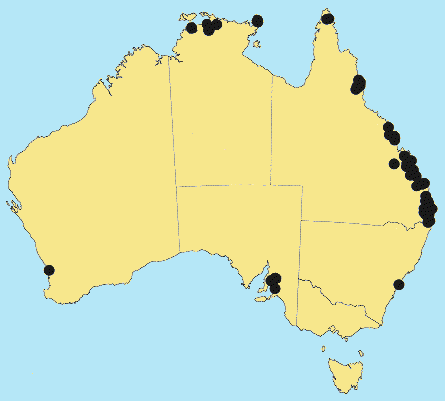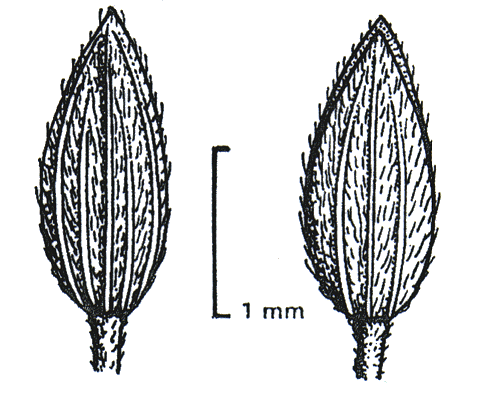Digitaria violascens* Link. Hort. Berol. 1: 229. 1827.
Classification. (GPWG 2001) : Subfamily Panicoideae. Paniceae.
Type of Basionym or Protologue Information: Brazil:, Herb. Link 93 (HT: B; IT: BAA-549 (fragm. ex B)).
Key references (books and floras): [1878] G.Bentham, Flora Australiensis 7 (461 as Paspalum minutiflorum), [1969] E.E.Henty, Manual Grasses New Guinea (80), [2002] D.Sharp & B.K.Simon, AusGrass, Grasses of Australia, [2006] J.Jessop, G.R.M.Dashorst, F.M.James, Grasses of South Australia (444), [2008] S.W.L.Jacobs, R.D.B.Walley & D.J.B.Wheeler, Grasses of New South Wales (221).
Illustrations: [2006] J.Jessop, G.R.M.Dashorst, F.M.James, Grasses of South Australia (443, Fig. 375), [2008] S.W.L.Jacobs, R.D.B.Whalley & D.J.B.Wheeler, Grasses of New South Wales, 4th edn (221).
Habit. Annual. Rhizomes absent. Stolons absent. Culms erect or geniculately ascending or decumbent, 20–60 cm tall, 2–5 -noded. Mid-culm internodes glabrous. Mid-culm nodes glabrous. Lateral branches sparsely branched. Leaf-sheaths glabrous on surface. Leaf-sheath auricles absent. Ligule an eciliate membrane. Leaf-blades flat, 3–25 cm long, 2–7 mm wide. Leaf-blade surface smooth, glabrous.
Inflorescence. Inflorescence digitate or subdigitate, with racemose branches. Racemes (2–)3–6(–9), 3–14 cm long. Central inflorescence axis 0–2 cm long.
Spikelets. Spikelets pedicelled, 3 in the cluster. Fertile spikelets 2-flowered, the lower floret barren (rarely male), the upper fertile, comprising 1 basal sterile florets, comprising 1 fertile floret(s), without rachilla extension, elliptic, dorsally compressed, 1.2–2 mm long. Rhachilla internodes brief up to lowest fertile floret.
Glumes. Glumes thinner than fertile lemma. Upper glume elliptic, 1.2–1.7 mm long, membranous, without keels, 3(–5) -nerved. Upper glume surface indumented. Florets. Basal sterile florets 1, barren, without significant palea. Lemma of lower sterile floret 100 % of length of spikelet, membranous, 5–7 -nerved.
Fertile lemma 1.2–2 mm long, without keel. Lemma apex muticous. Lodicules present.
Continental Distribution: Africa, Temperate Asia, Tropical Asia, Australasia, Pacific, North America, and South America.
Australian Distribution: Western Australia, Northern Territory, South Australia, Queensland, New South Wales, Lord Howe.
Western Australia: Drummond. Northern Territory: Darwin & Gulf. South Australia: Southern Lofty. Queensland: Burnett, Cook, Darling Downs, Moreton, North Kennedy, Port Curtis, South Kennedy, Wide Bay, Leichhardt. New South Wales: North Coast, Central Coast, Northern Tablelands, Central-Western Slopes.
Notes. Introduced. In tropical and subtropical rain forests, tropical and subtropical wet sclerophyll forests, tropical and subtropical sub-humid woodlands, and temperate sub-humid woodlands. A weedy species naturalized in coastal areas of eastern Australia, and recently introduced into S.A. and W.A. It prefers coarse-textured soils in disturbed habitats and woodland margins. Flowers mostly Jan.-May.



